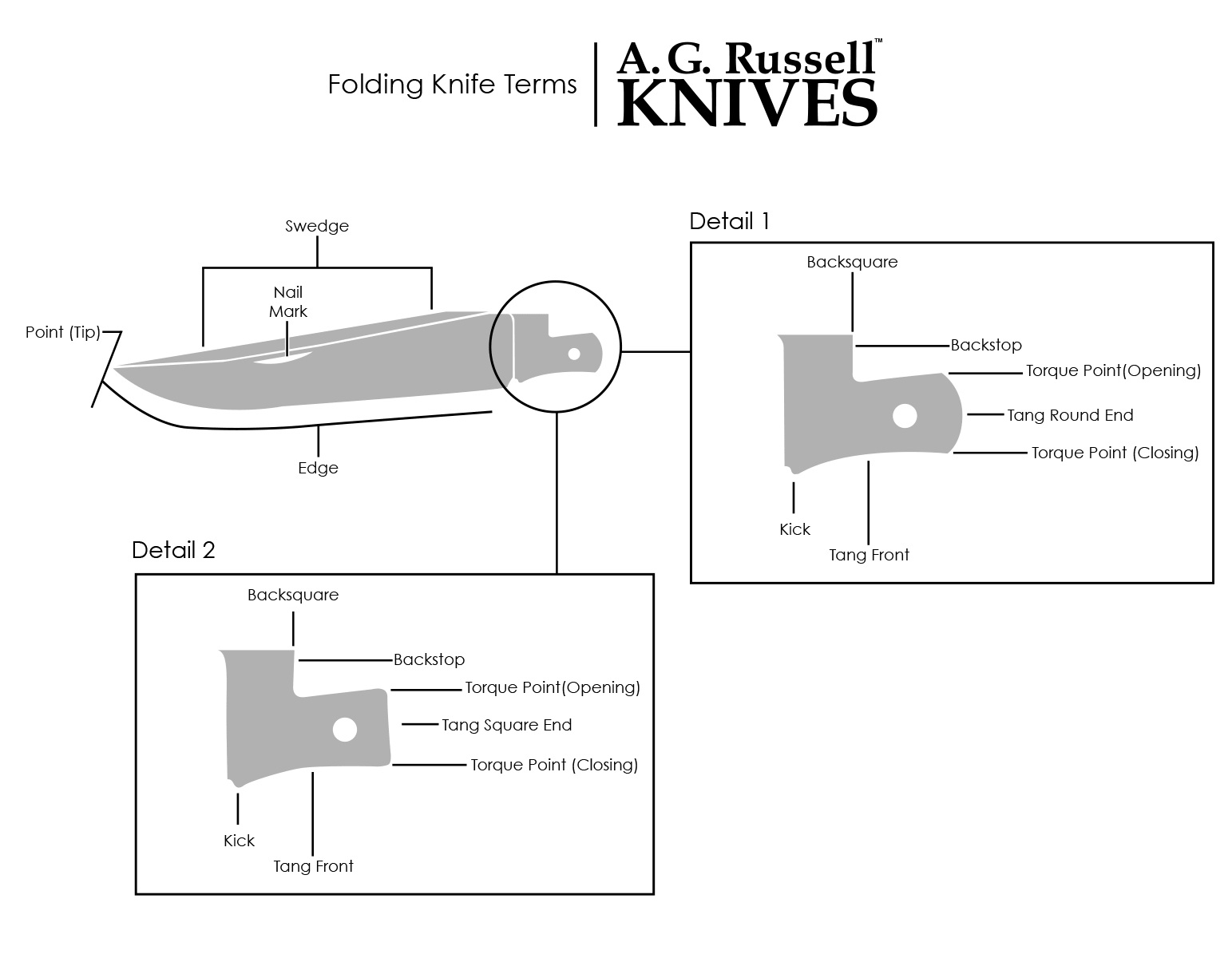Blade Parts for Slip Joint Folders
I will explain some of the different terms for parts of a folding knife on this page. This might satisfy some curiosity. Or you may find this information useful if you’re an amateur knifemaker yourself. In any case, I hope you find this to be an interesting read. Click on the image to see an enlarged version. Feel free to share this article’s link anywhere you wish. Some of these definitions use some more general folding knife terms in their explanations.
I should explain that these are the terms I use with my engineer, and when discussing knives with colleagues and manufacturers. These are the terms common to the cultures of 20th century Camillus, Schrade, and Bertram. Not all knife makers and manufacturers will agree 100% with me on all my knife terms, but these are the ones I use, and the ones I hear most often.
Blade Point (Tip)
The intersection of the front (edge) and back of the blade, intended for penetration or detailed cutting, very blunt on blades like the spey and very pointed on a blade like the clip point or stiletto.
Edge
In a well made knife it runs along the front of the blade from the tip to the choil. In a poorly designed or made knife there is either no choil or the plunge is too far toward the point, preventing the sharpening bevel to reach into the choil, this results in a poorly sharpened blade and ruined whetstones.
Choil
A small notch between the kick and the edge, allowing the edge to be sharp from tip to heel.
Edge Heel
The end of the edge, near the handle.
Plunge
The place where the grind begins leaving the tang unmarked. The ground area is much thinner, whereas the tang is much thicker than the ground area. The plunge is the transition between the two.
Swedge
A grind on the top of the blade, usually to allow a finer tip for better penetration. It can be very short as on the obverse of the spey blade or very long as in the case of California clip.
Common Swedge: Starts at the point and fades away toward the rear of the blade.
Cut Swedge: Begins at the point and ends in a shoulder or plunge.
Clip
To narrow the point (tip) of the blade you lower the back, this can be done with a curve resulting in a drop point or spearpoint blade shape. The other way is to grind a flat, slanting area from the back of the blade to the tip giving us what is called a clip point blade or clipped blade.
Nail Mark
The place cut or pressed into the blade where a thumbnail is used to open the blade. The common nail mark is crescent shaped, the long pull is used on blades with shorter clips and is a long narrow channel near the back of the blade.
Kick
A projection at the front blade end of the tang, in most old knives it rests on the spring stopping the blade edge from impacting the hump in the backspring.
Tang Front
Polished area between the kick and the torque point (closing).
Tang Back
Polished area between the backstop and the torque point (opening)
Tang Round End
The rounded end of the tang that results in a smooth transition of the blade from closed to open and open to closed.
Tang Square End
The square end of the tang that results in a jarring stop when the blade is half way open. Highly thought of by some collectors because of the difficulty of properly making it fit in todays handmade slipjoint knives where the tang end is flush with the end of the liners when the knife is closed and the tang back is flush with the liner ends when the blade is in half stop position.
Half Stop
A square end tang creates a point half way between the blade being open and being closed. When opening or closing, it stops the blade midway. This stop must be overcome to finish the movement.
Walk
The polished part of the spring front where the tang end and torque point move when opening and closing the blade.
Talk
The sound a blade makes when it snaps open or shut at the end of the walk, causing knife people to speak of the “Walk and talk” of the pocket knife, even though most of them have no idea of the meaning of “walk”.
Torque Point (Closing)
The small radius at the front end of the tang that moves along the walk of the spring causing the blade to snap closed.
Torque Point (Opening)
The small radius at the back end of the tang that moves along the walk of the spring causing the blade to snap open.
Backsquare
The sharp corner at the handle end of the blade back that sticks above the handle when the knife is closed and seems to threaten to rip a hole in the pocket. If this is not sharp it will not look good when open. In pen knives this was solved by using “sunk joints”
Sunk Joint
A method of hiding the backsquare by moving the pivot pin low enough in the handle that the backsquare is contained or nearly contained in the handle when the knife is closed.
Backstop
That area between the Backsquare and the tang back where the end of the spring stops the opening rotation of the blade.
Back to Knife Articles

